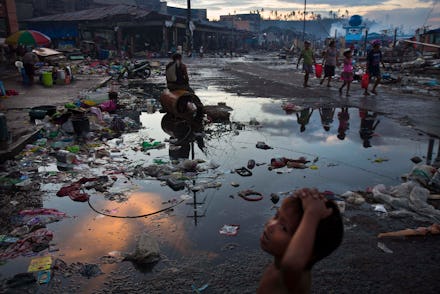Typhoon Haiyan's Hidden Costs

On Nov. 8, Typhoon Haiyan barreled through the Philippines causing a 16-foot storm surge, torrential rains, and engulfing everything in sight with its 160 miles-per-hour winds — a Category 5 hurricane. The typhoon was a tragedy and my prayers go out to those families who are now struggling. The costs of these natural disasters are mind-boggling when the loss of human life, physical capital, and rebuilding efforts are all taken into account. In these situations, claims are frequently made that government aid is the optimal solution for disaster relief and the economies of this community will flourish thanks to rebuilding efforts. This view is based on erroneous assumptions.
Typhoon Haiyan caused mass destruction leaving property mangled across the region, killing approximately 4,000 people, and leaving thousands more injured or lost in the debris. The Economist reports that "early estimates of the economic costs are about $15 billion." The costs could have been much higher if the storm had not passed through one of the poorest regions in the world.
To give some perspective, Hurricane Katrina was a weaker (Category 3) hurricane with 125 miles-per-hour winds when it made landfall near New Orleans in 2005, causing $125 billion in damages. In fact, Katrina holds the record for costliest Atlantic hurricane. Although Hurricane Katrina was a weaker storm, the economic costs were more than eight times greater because of greater economic development and prosperity along the U.S. coast than in the Philippines.
These catastrophic reports make it perplexing to read articles explaining how Typhoon Haiyan and other destructive events, such as 9/11 and Japan’s 2011 tsunami, boost economic growth. Proponents of this view argue that these disasters provide an economic stimulus due to the "jacuzzi effect," whereby upgrades and innovations are made in the wake of catastrophic events that might not have occurred if not for the disaster.
If we followed this rationale to its logical conclusion, we should burn buildings, throw rocks through windows, and pray for more natural disasters to stimulate economic growth.
The "broken window fallacy," conversely, demonstrates how unseen costs and unintended consequences must be considered when assessing the costs from a destructive event. In economics, the cost of a foregone alternative when pursuing a course of action is an "opportunity cost." This important concept must be considered when accounting for the costs of a disaster.
After any disaster, explicit costs can easily be tallied (e.g. bridges, buildings, machines, etc.) Implicit costs can go unnoticed (e.g. time, effort, lives lost, etc.) including what the funds could have been spent on instead of going toward rebuilding the region (i.e. opportunity costs.) Instead of spending money on demolishing destroyed houses and rebuilding them, imagine public and private funds spent on generating economic development in poor areas, improving failed schools, and upgrading dilapidated hospitals.
Furthermore, assistance in these situations is often delayed, due to the bureaucratic nightmare that is public sector aid. In general, government aid means well. The lack of incentives for the tracking of resources makes this type of aid ineffective and inefficient and thus the aid typically goes to inept or, worse, corrupt governments. Private sector resources from profit and non-profit entities provide aid much more efficiently because they have the incentive to track their funds appropriately and send dollars directly to those who need it most. Moreover, public sector funds come from the productive private sector, reducing donations to more efficient private sector entities — another opportunity cost.
While the region affected by Typhoon Haiyan may see a "jacuzzi effect" from a boost in their gross domestic product for a couple quarters during the reconstruction, there will be a drop in their standard of living that will not show up in the data. Specifically, the "broken window fallacy" from the lost productivity of the 4,000 deceased, the lower output due to the $15 billion in destroyed capital, and the resources employed to clean up and rebuild the region hit by this devastating storm are a drag on long-term economic growth.
As we question how disasters affect an economy, let us remember the opportunity costs associated with rebuilding efforts and inefficient government aid, not jump to erroneous conclusions about the economic and societal consequences of these events.